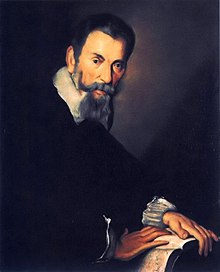Claudio Giovanni Antonio Monteverdi
[ˈklaudjo monteˈverdi](1567–1643, Italian)
Claudio Monteverdi's work marked the transition from the Renaissance style of music to that of the Baroque period.
He developed two individual styles of composition
– the heritage of Renaissance polyphony
– the new basso continuo technique of the Baroque
L'Orfeo
- a favola in musica (story in music), was one of the earliest operas, an innovative work that is still regularly performed.
'It is based on the Greek legend of Orpheus (Orfeo), and tells the story of his descent to Hades and his fruitless attempt to bring his dead bride Eurydice back to the living world.'
'The story was taken from Homer's Odyssey. After his long journey home from the Trojan Wars, Ulisse, king of Ithaca, finally returns to his kingdom where he finds that a trio of villainous suitors have seized the realm and are importuning his faithful queen, Penelope. With the assistance of the gods, his son Telemaco and a staunch friend Eumete, Ulisse vanquishes the suitors and recovers his kingdom.'
'One of the first operas to use historical events and people, it describes how Poppaea, mistress of the Roman emperor Nero, is able to achieve her ambition and be crowned empress.'
Nine books of madrigals
'Until the age of 40, Monteverdi worked primarily on madrigals, composing a total of 9 books. It took Monteverdi about 4 years to finish his first book of 21 madrigals for five voices. As a whole, the first 8 books of madrigals show the enormous development from Renaissance polyphonic music to the monodic style typical of Baroque music.'
Il ritorno d'Ulisse in patria / The Return of Ulysses
L'incoronazione di Poppea / The Coronation of Poppaea
Nine books of madrigals
'Until the age of 40, Monteverdi worked primarily on madrigals, composing a total of 9 books. It took Monteverdi about 4 years to finish his first book of 21 madrigals for five voices. As a whole, the first 8 books of madrigals show the enormous development from Renaissance polyphonic music to the monodic style typical of Baroque music.'▪ monody = solo voice + basso continuo
* Lamento della Ninfa / Lament of the Nymph
* Hor che'l ciel e la terra / Now that heaven and earth
* Sì dolce è il tormento / 甜蜜的折磨:
* Luci serene e chiare / Serene and clear lights
* Sì ch'io vorrei morire / Yes, I would like to die
* Cruda Amarilli / Cruel Amarilli
Sacred Music
Vespro della Beata Vergine / Vespers for the Blessed Virgin / aka Vespers of 1610
'Vespers (evening prayers) is a set of daily prayers of the Catholic Church which have remained structurally unchanged for 1500 years.
'In scale, Monteverdi's Vespers was the most ambitious work of religious music before Bach. This 90-minute piece includes soloists, chorus, and orchestra and has both liturgical and extra-liturgical elements.
'Vespers is composed around several Biblical texts that are traditionally used as part of the liturgy for several Marian feasts in the Roman Catholic church.' ...Wikipedia
■ This setting of the Ave Maris Stella sung during Vespers for the Blessed Virgin between
* the monastic choir singing Gregorian chant and
* the choir singing in alternate verses in polyphony.
■ This beautiful setting and method of singing Hymns and particularly the great hymn for Our Blessed Virgin became very popular in the early part of the 17th Century all across Europe.
■ The work contains a mixture of both stile antico and moderno, and a reworking of an instrumental toccata from L'Orfeo.
文藝復興與巴洛克音樂的分水嶺
“Prima le parole, poi la musica”
『首要是文字,然後才是音樂。』
—— Claudio Monteverdi (1567-1643)
要說文藝復興與巴洛克音樂根本上的分別,就必然會提到意大利作曲家Monteverdi這句名言,這句話清楚講述了文字(歌詞)在巴洛克音樂裡面的重要性。
其實講述這個題目,我更偏向使用Prima pratica來表示『文藝復興音樂』,然後Seconda pratica來表示『巴洛克音樂』) :
▪Prima pratica主張音樂為主,文字為輔,音樂作品必須按照嚴謹的對位法寫成,然後把歌詞隨便貼上去就可以。
▪Seconda pratica則主張文字為主,音樂為輔,音樂的存在就是為了襯托文字,讓意思更加突出,更加可以為了凸顯某些重要的意思而打破傳統的對位法規則,於是音型學這個產物就出現了。

No comments:
Post a Comment